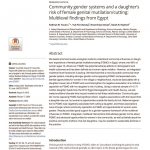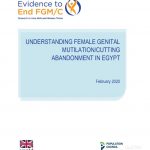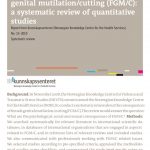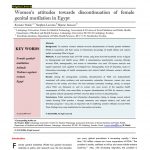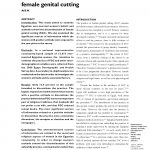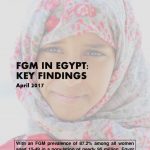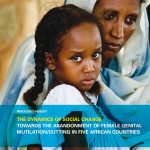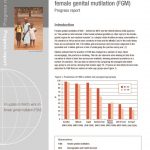Egypt

- Australia
- Benin
- Brunei
- Burkina Faso
- Cameroon
- Canada
- Central African Republic
- Chad
- Colombia
- Côte d’Ivoire (Ivory Coast)
- Denmark
- Djibouti
- Egypt
- Eritrea
- Ethiopia
- France
- Germany
- Ghana
- Guinea
- Guinea-Bissau
- Indonesia
- India
- Iran
- Iraq
- Ireland
- Jordan
- Kenya
- Kuwait
- Liberia
- Malawi
- Malaysia
- Mali
- Malta
- Mauritania
- Mexico
- Niger
- Nigeria
- Oman
- Pakistan
- Peru
- Portugal
- Russia
- Saudi Arabia
- Senegal
- Sierra Leone
- Singapore
- Somalia
- Somaliland
- South Sudan
- Spain
- Sudan
- Sweden
- Switzerland
- Tanzania
- Thailand
- The Gambia
- The Maldives
- Togo
- Uganda
- United Arab Emirates
- United Kingdom
- United States of America
- Yemen
- Zambia
- Zimbabwe
Population
99.8 million
Estimated prevalence among girls and women aged 15-49
87%
2018 population growth rate
1.87%
Estimated prevalence among girls and women aged 15-19
70%
Type practised
The most widely practised forms of female genital cutting (FGC) in Egypt are Type I and Type II.
Age
Almost all girls and women in Egypt (96%) undergo FGC before the age of 12. The majority of girls (64%) undergo FGC between the ages of nine and 12.
Source: UNFPA-UNICEF
Agent
The main practitioners are health providers. Since at least 2008, there has been an increase in the medicalisation of FGC in Egypt. The 2015 Health Issues Survey shows 79% of girls from 0-17 underwent procedures carried out by health professionals.
Source: UNFPA-UNICEF
Legal status
Illegal. Legislation criminalising FGC has been in place since 2008. Enforcement is inadequate, however, with convictions rare and sentences lenient.
Source: UNFPA-UNICEF
National progress
-
1994 – Egypt adopted a regulation approach through medicalising the practice in a 1994 Ministry of Health Decree, which rolled back a 35-year ban on practising FGC in state hospitals. The policy was reversed the same year, but allowed a loopphole for “medically necessary circumcision” which continued until 2007
-
1996 – FGC in Egypt first made illegal
-
2008 – New FGC legislation introduced via amendments to the Child Act (1996) and Penal Code, although medical practitioners continue to perform FGC
-
2016 – Amendment of anti-FGC law to include stricter penalties, making FGC a crime rather than a misdemeanour
- 2016 – National strategy, entitled Family Empowerment and FGM Abandonment, launched
- 2017 – FGC multi-sectoral task force established
- 2017 – Fatwa condemning FGC; Azhar Supreme Council Statement confirmed FGC has no basis in core Islamic law
- 2017 – Integration of FGC into university curriculums
- 2018 – The Egyptian Dar Al-Iftaa (Centre for Islamic Legal Research) made a significant ruling that FGC is religiously forbidden and that the practice is not required under Islamic laws and should be banned
- 2018 – The Egyptian Minister of Health, Ahmed Emad, presented six steps to eliminate FGC by 2030
UN programme
During Phase II of the UNFPA-UNICEF joint programme (2014-2017), 31,138 families and 30 communities made public declarations of FGC abandonment.
Source: UNFPA-UNICEF
Human Development Index ranking
115 in 2018 index, based on 2017 data.
Infant mortality rate
20 deaths per 1,000 live births (2015).
Source: 28 Too Many
Maternal mortality rate
33 deaths per 100,000 live births (2015).
Source: 28 Too Many
Trends in FGC prevalence
Prevalence rates have decreased in recent years (from 91% in 2008 to 87% in 2015, according to EHIS 2015). Since the 2011 revolution, however, the perception of efforts to end FGC being attached to the overthrown Mubarak regime meant that challenges and obstacles to the work to end FGC in Egypt have increased. The 25th January 2011 Egyptian revolution led to uncertainty and freezing of FGC programmes. The Muslim Brotherhood period from 30th June 2012 – 3rd July 2013 also resulted in regression on programming on the practice, and since the Al Sisi regime began in July 2013, there has been no evidence of a systemic movement against cutting. In addition, around half of people in Egypt still support the continuation of FGC and believe it is a religious requirement.
Source: UNFPA-UNICEF
Prevalence breakdown
By region
FGC in Egypt is widely practised. Prevalence rates above 80% are seen across large parts of the country, with only a relatively small area in the north-west displaying a rate below 25%.
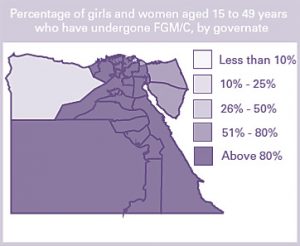
Source: UNICEF and UNFPA-UNICEF

